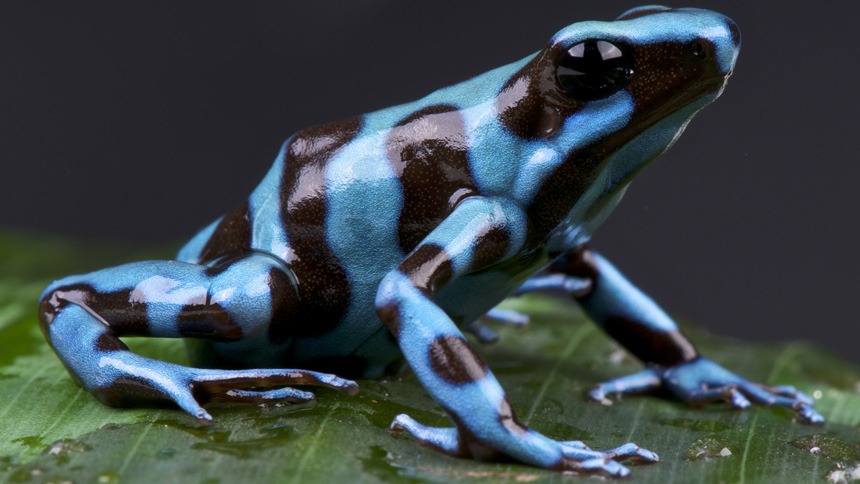
Poison Dart Frog Care Sheet & Pet Guide
Also known as Poison Arrow Frogs (Dendrobatidae)
These amazing amphibians are one of the most popular frogs kept as pets. Their exotic patterns and bright colors are no doubt the reason for their popularity. Poison dart frogs are fascinating creatures and this page is all about how to properly care for them as pets.
They go by many different names but one of their more popular names is “Poison Arrow Frog”. In South America, natives used to extract toxins from dart frogs in the Phyllobates Genus and apply them to their arrows in order to make them more effective.
Despite all this, dart frogs make great pets in captivity. Hence the reason for this care guide. On this page, I’ll do my best to cover all the information you’ll need to successfully raise happy, healthy dart frogs. From the equipment you’ll need to the diet and more, you will find it all here.
Page Contents
Poison Dart Frog Habitat Setup
A dart frog setup is one I don’t recommend for complete newbies. These frogs require high humidity and the recommended equipment gets expensive. If you’re new to amphibian care and can’t live without getting a poison-dart frog as your first pet, that’s fine – just be sure to do your research first!
A quality setup includes a terrarium, a dependable misting system, lights, a drainage layer, and microfauna. That’s not everything, mind you. I’ll go into greater detail below.
Despite the initial cost, upkeep isn’t bad and the enjoyment you’ll get from keeping dendros is well worth it in my opinion.
Here is a list of the items I recommend.
- Terrarium / Enclosure – You’re going to need an enclosure. The size largely depends on the number of frogs you’re keeping together. Many dart frogs are best kept in pairs and require a minimum of a 29-gallon tank while some species do best in a large 36x18x18. I recommend a 24x18x18 Exo Terra for most setups holding 2 – 4 dart frogs.
- Substrate – Because poison dart frogs require high humidity, it’s important to utilize your substrate to retain water in order to hold higher humidity within the cage. But the substrate can’t hold water to the point where it becomes soggy and stagnant. Those conditions promote mold and bacteria growth. You’ll want to utilize moss on top of an ABG mix on top of a drainage layer. Leaf-litter is nice as well.
- Drainage Layer – A drainage layer allows excess water to drain through the substrate to the bottom of the enclosure. This consists of a mesh layer between the substrate and the bottom layer. The bottom layer is where the water sits until you pump it out. Many people use hydroballs or something similar. I’m personally a fan of matala filter media.
- Plants, Branches, Decorations – Whether you use live or fake plants is up to you. I recommend live plants, especially if you’re going for a naturalistic setup. Either way, you’ll need some plants and branches to decorate the terrarium.
- Lighting – Using the correct lighting is a must if you plan to grow live plants. Aside from that, dart frogs need a day and night cycle. 12 hours or day/light and 12 hours of dark/night. T5 grow lights are popular in the trade while others choose to use LED bulbs or fixtures.
- Misting System or Fogger – Because the humidity needs to stay above 80%, a recommended product is a misting system or fogger. They can get expensive, too. They’re well worth it, though.
- Thermometer / Hygrometer – One of the most important things to check is the temperature and humidity. You need a thermometer / hygrometer combo for this.
- Thermostat – This may not be needed depending on your setup and the average temperature in your home. In case you do, I’ve created a guide for the best thermostats for terrariums.
Most people who keep dart frogs go for a bioactive vivarium setup. Something with real, living plants and even microfauna that serve as janitors and an additional food source.
This is a whole topic by itself. If you’re new and want to know more, I suggest watching some YouTube videos about the topic of vivariums.
Temperature
Dart frogs do not tolerate fluctuations in temperature very well. It’s important to keep a close eye on the temperature in their enclosure and keep it within the recommended range.
- Temperature range between 68 – 76 °F
This is a great temperature range for most Dendrobates. They will tolerate short periods of time in the low 80s but don’t let it happen very often. Anything at or above 85 degrees will quickly lead to injury or death.
A great way to monitor the temperature is by using a thermometer. There are several companies selling thermometer/hygrometer combo meters that measure the temperature and humidity. The readings are output on a small digital display and they’re relatively inexpensive.
Humidity
One of the reasons I consider poison dart frogs difficult to care for is because they require near 100% humidity (80% – 100% to be precise).
- Humidity range between 80% – 100%
In order to achieve this, you’ll have to make use of moss, the correct substrate, lots of misting (preferably via a misting or fogger system), and you may even need to cover the top of the terrarium with a piece of glass.
Doing this can cause problems with air circulation and mold and bacteria growth in the substrate. This is probably the main reason I rank poison dart frogs in the “difficult to care for” category.
Humidity levels at or below 50% for a sustained period of time will result in injury or death.
Lighting
The main reason for lighting is to provide a day and night cycle for your frogs. Roughly 12 hours of light and 12 hours of dark. Place the lights on a timer so the day and night cycle is fluctuating each day.
- A day and night cycle of 12 hours each. UVB is not required.
UVB isn’t considered a requirement for poison dart frogs although studies suggest UVB is beneficial for some amphibians. It helps regulate vitamin D3 which is good for healthy bones and other health benefits.
Despite this, most keepers don’t provide a UVB light and instead use calcium with D3 supplements. Should you decide to provide a UVB light for your dart frogs, a low-powered one is recommended. Sources under 5% UVB are ideal.
Lighting becomes more important when you’ve got live plants in your enclosure. Live plants require special lighting to keep them growing healthy.
Grow lights are increasing in popularity and many keepers go with T5 bulbs while others prefer LED grow lights. Whichever you choose, make sure they’re not overheating the habitat and you’re still sticking to the day and night cycle of 12 hours of light and 12 hours of dark.
Substrate
You have plenty of options when it comes to the substrate. Ideally, you’ll want something that retains a fair amount of moisture. This will help keep the humidity where you want it.
- ABG Mix, Moss, and Leaf Litter
The downside to moisture-retaining substrates is that they can become a problem for a terrarium without a drainage layer. Substrate sitting in moisture can result in mold growth over time.
For this reason, you should put your substrate on top of a drainage layer. A drainage layer allows water to drain below the substrate layer.
Once enough water has collected below the substrate layer you can drain it off or otherwise remove it from the enclosure. This keeps the substrate from becoming saturated with water which would cause problems over time.
As for the substrate itself, I suggest trying an ABG mix if you intend to grow live plants. ABG stands for “Atlanta Botanical Garden”.
If you decide to go with an ABG mix, I recommend doing some more research on the topic but one of the popular ABG recipes is listed below:
- 1 part peat moss
- 2 parts tree fern
- 1 part sphagnum moss
- 2 parts orchid bark
- 1 part lump charcoal
In addition to the substrate of your choosing, using moss will help greatly with water retention and thus humidity. Moss is great on branches, rocks or simply sitting on the substrate.
Leaf litter is recommended as well. It helps complete a naturalist habitat but it also provides a food source for springtails and isopods (read more about this in the diet section below). It also gives your beloved dart frogs more hiding spots.
Hiding spots created by leaf litter is beneficial because it helps your frogs feel more comfortable. The reason they feel more comfortable is that they know they have a nearby hiding place should they need it.
This gives them more confidence to venture out into the terrarium and allows you more opportunities to observe them.
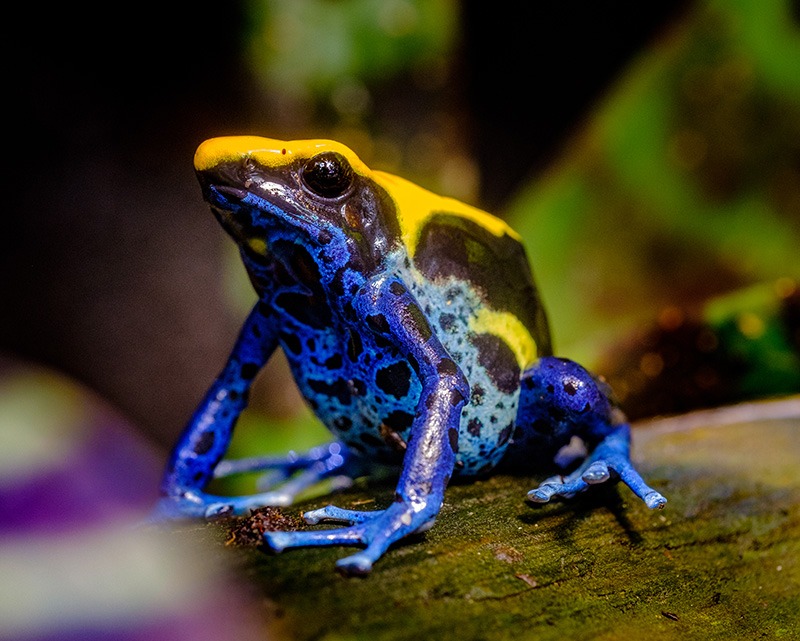
Water Quality
Quality water for amphibians is of paramount importance for amphibians. Their skin is semi-permeable which allows them to more easily absorb substances through their skin.
- Clean, dechlorinated water
Any type of chemical (soap for example) is easily absorbed by an amphibian while being held by a person who simply didn’t wash their hands properly.
In addition to this, chemicals in tap water will have a negative effect on the health of your pet dart frog. Most municipal water treatment plants utilize chlorine and/or chloramines to treat your drinking water before it leaves the plant.
Chlorine levels are adjusted to remain in the water for the period of time it takes water to go from the treatment plant to your house. It’s there for good reason too – it kills pathogens that get in the water lines while en route to your house.
It’s considered safe for human consumption but using it on your small amphibian can have adverse effects. For this reason, always treat your tap water with a water conditioner like ReptiSafe (or similar water dechlorination agent). Springwater or RO (reverse osmosis) is great as well.
Remember this when filling foggers and misting systems with water. Any water that comes into contact with your frogs needs to be clean, dechlorinated water.
Plants, Branches, and Decorations
The use of plants and branches is recommended as they provide hiding places for your poison-dart frogs. Generally, the more hiding places you have the more comfortable your frogs feel. As they feel more comfortable, they’re more likely to venture out into their enclosure.
The type of plants you can use is mostly limited to the environment in which they’re placed. Tropical plants that do well in high humidity are your best options for this type of setup. You can find a number of accessories for your frog’s habitat to help fill the space.
Also, the size of your dart frog matters. The bigger and heavier they are, the more easily they will crush your plants. Moss will make a great covering for the substrate, rocks, and branches, but the plants you pick need to withstand the weight of the frog it’s supporting.
A list of plants that do well in Dendro enclosures:
- Golden Pathos
- Snake plants
- Bromeliads
- Pilea
- Ferns
As for branches, you can use a variety of woods found in your local pet store. I created a post on popular terraria wood to help you get started. Remember that you’re going to have high humidity levels so go with branches that withstand moisture really well.
Poison Dart Frog Diet
Due to their small size, dart frogs are limited in what they can eat. You need to provide them with a decent number of small feeder insects. Luckily, their preferred sources of food are fairly easy to obtain and even raise/culture on your own.
- Fruit Flies (“Flyless fruit flies”)
- Pinhead Crickets (1/8″ baby crickets)
- Springtails
- Isopods
The most economical choice is fruit flies. Raising feed insects isn’t within the scope of this guide but I recommend culturing your own fruit flies to supply the main source of food for your dart frogs.
Pinhead crickets are another great option. They’re more difficult to raise than fruit flies but if you want to offer your frogs a variety of insects, I recommend crickets too.
It’s important to note that pinhead crickets are tiny – between 1 to 3 days old. They’re not much bigger than 1/8th of an inch in length. They should be fed a nutritional diet 24 – 48 hours before giving them to your frogs. This is referred to as “gut loading”.
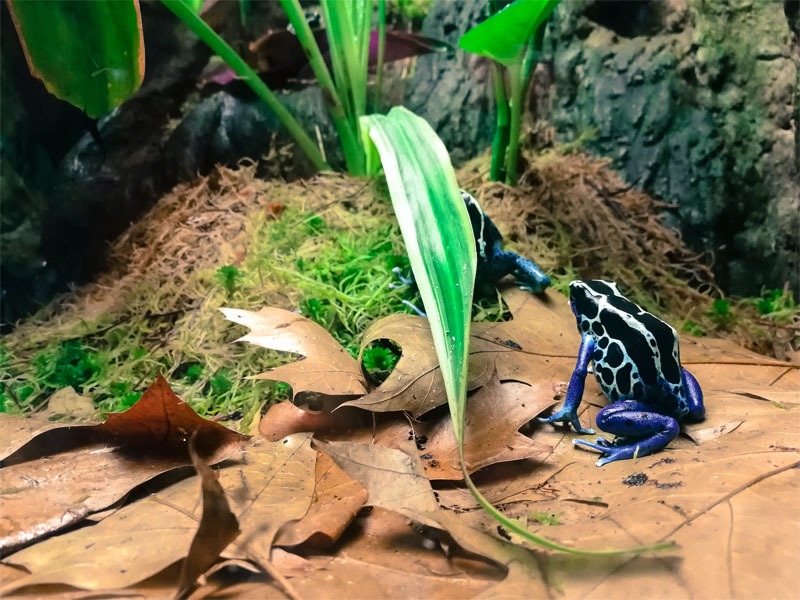
Springtails and Isopods serve as a food source as well. Both of these are part of a bioactive vivarium’s clean-up crew. They break down decaying plant matter, droppings, etc. They create air pockets by tunneling through the substrate which helps your plants grow healthy.
They’re small and populate quickly in the right environment. While springtails aren’t very big and both springtails and isopods shouldn’t be your poison dart frog’s main source of food, they’re still considered a healthy supplemental source of food.
How much and how often you feed them depends on the dart frog’s size and age. There isn’t a set number in which to feed them. The main purpose is to provide your pet frogs with enough food to keep them healthy while not overfeeding them. The size/age of the frog plays a factor in how much they will eat.
A good starting point is to feed an adult dart frog 75 – 100 fruit flies every other day or 3 times per week. Again, this is a starting point. I recommend trying this and monitoring how many flies go uneaten.
If a lot of flies go uneaten, decrease the amount you give them the next feeding. If your frogs quickly eat all the flies every time you feed them, consider increasing the number of flies at the next meal.
Keep an eye on your dart frogs to ensure they’re not getting overweight. Simply use this method to determine the right amount of food to give your frogs.
Juvenile poison dart frogs will eat around 40 – 50 fruit flies every other day. You can feed them daily (20 – 25 per day) if you prefer.
You’re not expected to count every fruit fly you feed your frogs! It’s near impossible because they’re so small and moving around. The best advice I can give you is to consistently monitor your frog’s eating habits and adjust the number of flies you’re giving them to suit their needs.
- Supplement with Vitamins and Minerals
In the wild, amphibians consume a large variety of insects to meet their nutritional needs. Because they don’t have access to this large variety of food sources in captivity, you need to dust their food with vitamin and mineral supplements.
I’m talking specifically about their main source of food, which will likely be fruit flies or pinhead crickets. You’ll want to give them a light dusting of your vitamin/mineral supplement with each feeding. Don’t overdo it. Just ensure most of the flies/crickets gets a thin coating of supplement powder.
Handling Dart Frogs
While poison dart frogs aren’t considered harmful on a captive diet of fruit flies or pinhead crickets, that doesn’t mean you should make a habit of holding them. They’re small, delicate amphibians that shouldn’t be handled very often.
Handling dart frogs is generally frowned upon. It created unwanted stress for your treasured little pets. In addition to causing stress, you run the risk of passing harmful chemicals on to your dart frog if your hands aren’t clean enough.
Spot cleaning their habitat is fine and even occasionally moving your frog into a small container is okay. After all, you may need to deep clean their enclosure once in a while and the best way to do this is by placing your frogs in a separate container while you clean their tank.
Popular Dart Frog Species
There are over 100 species of poison dart frogs in the world. They all have varying sizes, colors, and patterns. With that in mind, there are a few species that are more popular than others.
Listed below are some of the most popular dart frogs kept as pets. Don’t get offended if you don’t see your favorite one here. This isn’t ranked in order and it doesn’t include every species.
Auratus
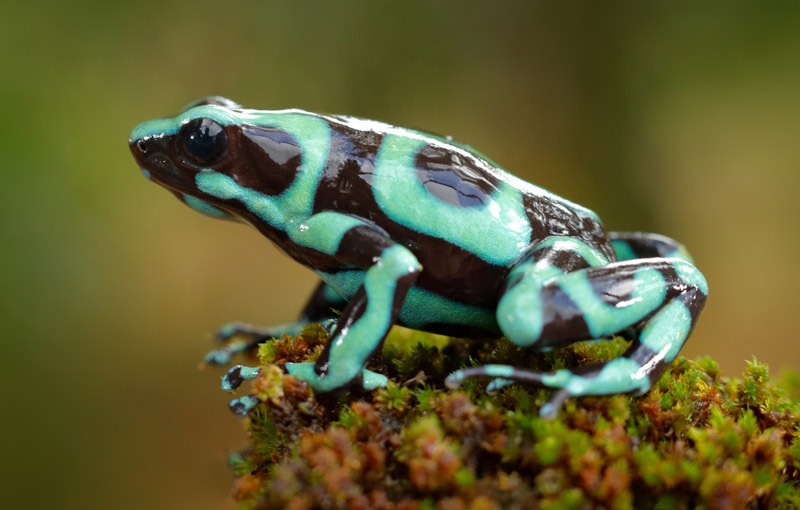
D. Auratus is another popular one. Their highly attractive black/green coloration is a selling point. Females get up to about 1″ in length while males are slightly smaller, around 3/4″ in length.
While they’re certainly popular, they can be a bit more difficult to care for. Fluctuation in temperature and humidity isn’t tolerated as well as with other species.
Tincs
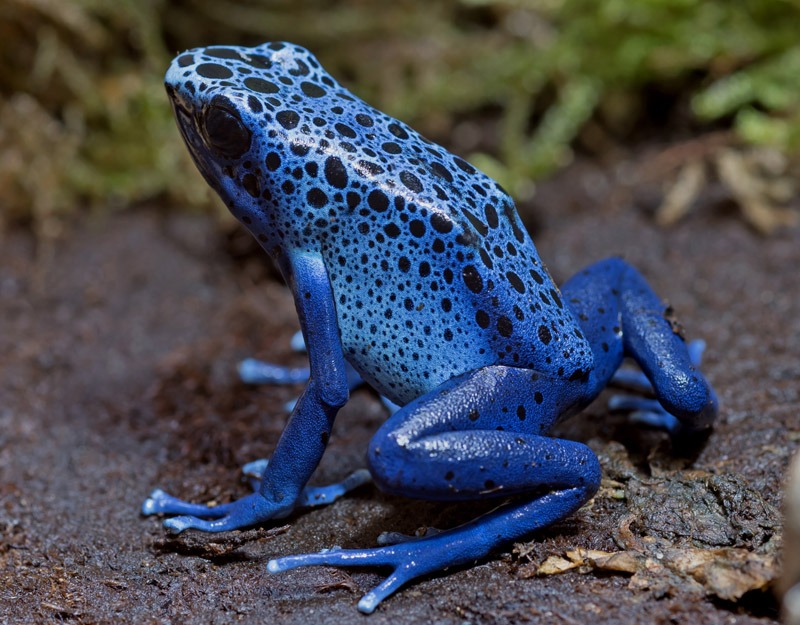
If I had to guess which species was the most popular it would be this one, Dendrobates tinctorius. Their English common name is is “Dyeing Poison Arrow Frog” but they’re commonly called “Tincs”.
There are several different subspecies and morphs which, I know, makes this a bit more confusing. Since the scope of this article is dealing with raising healthy Dendrobates, I won’t go into much detail about the minor differences between subspecies.
Leucs
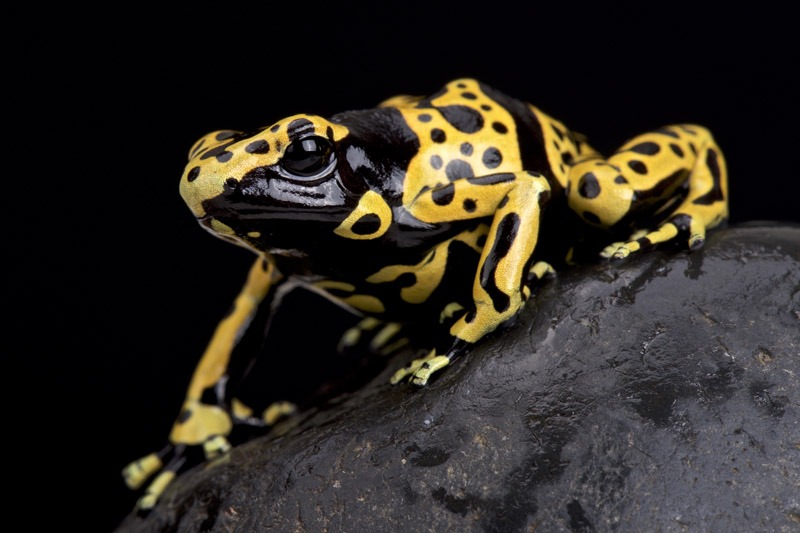
Leucs are really popular as well. There are two subspecies that have been mixed to make interesting yellow patterns.
Some look more striped while others look more spotted.
Poison Dart Frogs In the Wild
Poison Dart Frogs (Dendrobatidae) are endemic to Central and South America. They need a humid, tropical rainforest environment to survive. Because of this, you’ll find them in Brazil, Colombia, Panama, Ecuador, Costa Rica, and surrounding areas.
Terrestrial in nature, they spend most of their time on the ground. Sometimes, however, you can find them in low-hanging plants and trees, a few feet off the jungle floor.
They feed on a variety of live insects. Centipedes, mites, ants, and flies. Interestingly enough, it’s their diet in the wild that contributes to their toxicity. At least this is what all the evidence points to.
In the wild, certain poison dart frogs are deadly, producing extremely dangerous toxins. Those same frogs aren’t so dangerous in captivity – provided their diet consists of non-alkaloid-containing insects. This is how we’re able to safely keep them as pets.

14 Comments
This is very informative for people thinking about becoming Poison Dart Frog owners. Thank you for taking the time to make this website. I learned more here than any other site I’ve viewed, and will continue researching Poison Dart Frogs, their care, and their habitats, before I purchase one. I can see they do take some initial thought and education whereas other websites advertise them as “easy pets”. I am glad I kept researching and found your website.
Thanks for your nice comment! Glad you found this information helpful. Good luck if you choose to get some Dart Frogs!
Hi I have a large aquarium could I adapt that to keep frogs in
Thank you
I wished that
What kind of dart frog is in the very first image? Is it a Tinc as well?
Its actually a blue Dendrobates auratus, which are typically green. There are different morphs including the “super blue”
I’m thinking of starting up with dart frogs. I’ve experience with alpine newts. My main question is do I need a thermostat if I’ve got a thermometer and hygrometer combo.
A thermostat is a device that helps control the temperature. It works by turning a heating element on or off depending on the temperature! A thermometer simply reads the temperature and outputs it on a display! Whether or not you need a thermostat depends on your situation and if you need a heating element to turn on at a certain temperature and shut off at a certain temperature! I hope this helps.
I have a 35 gallon hex aquarium. Can I use the standard aquarium top or do I need to make a special top for it? And if so what kind of requirements need to be met? Do the frogs like to climb on the lid so to speak?
I don’t see why not, Aaron! So long as your frog can’t escape lol. You probably won’t have a problem with Poison-dart Frogs though.
Hi! I am just following up with a question regarding cleaning. I would like to purchase a smaller tank for times when I will be doing deep cleaning and the frogs need to be moved temporarily. Any recommendations for a smaller, temporary terrarium?
Any type of plastic container with ventilation will work! I’ve used Tupperware with small holes cut in the top/sides. If you want something a bit more dependable, I’d recommend getting an “imagitarium” or something like a “cricket keeper”. They’re usually $10 – $30.
I have a paludarium with fish and shrimp that could be affected by the poison in the frogs. I was wondering if their poison will affect water perameters. Please let me know.
I found the details listed in the info page helpful,as a newbie 2020 I search for all the information I can glean, have kept and bred many reptiles over many years and was luck enough
to have a certain amount of equipment to get started with dart frogs.
was also lucky to be able to buy a few species during lock down, but would like more.
With all the IHS shows cancelled, not finding it easy.
Regards Arthur